|
 |
Every
bicycle collector in the Netherlands is familiar to cross frames. Some 50 years ago, every
self-respecting Dutch bicycle factory had at least one in its assortment. When you tell an
Englishman that you have five cross frames in your collection, he will look at you in
wonder, whereas a German would ask you in reply what you are talking about. How come, and
how did the phenomenon of these cross frames evolve through the decades?
|
 |
| Historical evolution |
| First generation

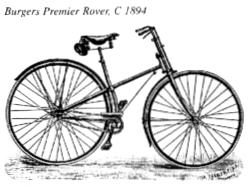 The
first bicycle to be called a cross frame was the "Premier" in 1886, made by the
(British) Hillman, Herbert & Cooper in 1886. The cross frames were one of the first
safeties and were made by several companies until the nineties. The cross consisted of the
seat tube and a tube that connected the head tube to the rear axle (the last part of
course as a fork, encasing the rear wheel). A down tube failed. The
first bicycle to be called a cross frame was the "Premier" in 1886, made by the
(British) Hillman, Herbert & Cooper in 1886. The cross frames were one of the first
safeties and were made by several companies until the nineties. The cross consisted of the
seat tube and a tube that connected the head tube to the rear axle (the last part of
course as a fork, encasing the rear wheel). A down tube failed.
Second
generation

The second generation cross frames was British as well, getting into fashion around the
turn of the century. The diamond-frame had evolved to the standard-type bicycle. Whereas
the first generation cross frames can be considered as a frail precursor, these new cross
frames were basically variations on the diamond-frame reinforced by extra tubes. Lots of
variations were designed, but probably not all of them made it to the production line:
|
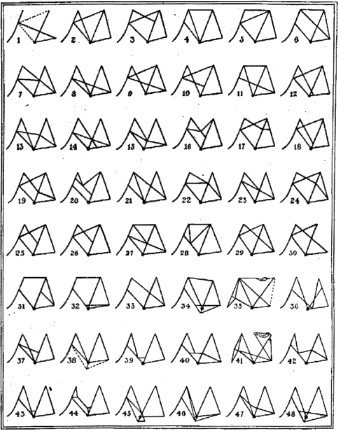
from: De Kampioen, 1901
|
| The names
were numerous, too. A cross frame having two tubes crossing in the middle was called an X-frame.
Other names for bicycles with an extra reinforcing tube were girder frame or truss
frame, derived from load-bearing constructions. The Quadrant bicycle (built under
licence by Alt in Leiden, the Netherlands) is an example of such a girder-frame, the
girder being the diagonal extra tube in the diamond-frame. In the Alt-catalogue, the two
short tubes behind the bracket are mentioned as duplex-tubes, although strictly -according
to an expert from England- these are 'struts', making this a 'strutted girder frame'. |
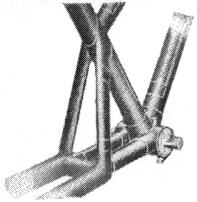 |
| Quadrant Duplex Girder |
A duplex
girder frame or duplex cross frame was a frame that was made -in part- in duplex-tubes:
small double tubes that could replace single tubes of a regular diameter. Some of the
names of special frame designs in old brochures are derived from these terms, as Girplex,
Crossex or Trussex.

By 1901, this new fashion came to the Netherlands. Some of
these cross frames were imported to the Netherlands, some manufacturers (amongst which
Eysink, Fongers, B. A. Jansen and Simplex)
made their own models. |
 |
In the
Dutch magazine 'de Kampioen' from the 19th of April 1901, a detailed article covers the
"new bicycle fashion" of cross frames:
|
In England, a new
bicycle fashion has started, that is used at the moment by several large manufacturers on
the other side of the Channel as a means to wake up the community. This new fashion is
that of the X-frame, and because it is about to come to our country, we consider it our
duty to inform our readers of its existence and its practical meaning for the sport. ... |
|
 |
The rest
of the article comments on "a scientifically proven mistake in the current model
frame: the mistake of lateral suspension". As a result, a regular bicycle would be
more likely to slip sideways on a slippery surface and some pedalling energy would be
lost.

The progress that could be achieved, was much discussed
about. The Humber company, for example, was rather candid about how useless they
considered the invention. However, they weren't too stubborn to listen to the customers: |
|
Frankly, we do
not see the necessity of manufacturing a stronger frame than the diamond frame which we
make since years and which is copied by the large majority of bicycle manufacturers.
However, many riders will get the impression that the cross frame is the newest and the
fashion bicycle of 1901, because of the publicity that is made. Despite the fact that we
declare that we are convinced that there is no urge for this novelty, we see no objection
to honour our customers' requests. ... We have considered this decision very well and it
has cost us a great deal to be able to bring our cross frame to the trade. |
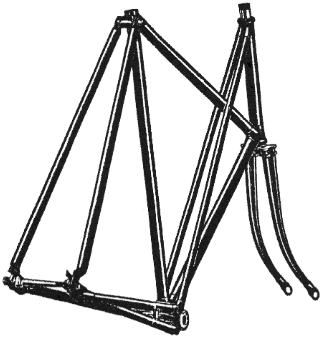
|
|
What this
move lacked from a marketing point of view was made up for by the design of the bicycle.
By the way, the double-tubed front forks could be found at Humber bicycles until the early
sixties.

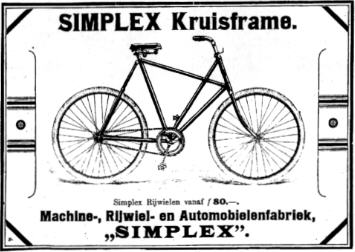 In the
Netherlands it seems to be that it took less than ten years for the cross frames to
disappear from the brochures. In Germany, it was even less successful: they are
practically unknown. In the available literature, we found only one model from the brand
Brennabor. In the
Netherlands it seems to be that it took less than ten years for the cross frames to
disappear from the brochures. In Germany, it was even less successful: they are
practically unknown. In the available literature, we found only one model from the brand
Brennabor.

In the UK, however, homeland to the bicycle industry, cross
frames were manufactured up to the thirties. Raleigh, that had them in their collection as
early as 1897, kept on advertising them 'at home' up to 1935, and in the Netherlands even
until 1936.Third
generation

At this point, we have arrived at the third phase in the history of the cross frame
bicycles. In the Netherlands -and obviously in no other country- the cross frames became
really popular by the late thirties, together with the reintroduction of a different
category bicycles: the tandem, and a flourishing development of the (bicycle-)industry.
After the depression of the first half of the thirties, people bought more bicycles,
obviously providing opportunities for more special models.

One of the first, if not the first, was Gazelle in 1930. Other well-known brands like Simplex, Juncker, Locomotief and Germaan followed suit in
the late thirties. In the early fifties, every major brand had one or more models in its
collection, with the striking exception of Fongers. The probably most popular model was
the Locomotief "Super de Luxe", which was promoted as a unisex cross frame.
|
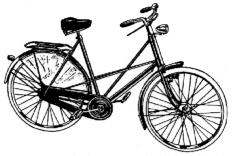
Locomotief unisex cross frame,
app. 1936 - 1955
|
| In the
late fifties, the pendulum swung for these bicycles, and by the sixties -as far as we
know- again only Gazelle kept on producing cross frames. After that, silence fell for
twenty years. Fourth generation

In the eighties, things started to happen
in the bicycle business. Bicycles became a fashionable thing, and together with the
'randonneurs', MTBs and ATBs, on a smaller scale, cross frames appeared. Van Raam from
Aalten, the Netherlands, was an early adapter and provided a model like the Locomotief
under his own brand, and from 1984 for Utopia in Germany. Since app. 1985, Batavus sells a
comparable model for ladies and a duplex-reinforced gents' model. These bicycles are also
being sold under the Altra-brand. In 2001, Gazelle introduces a very similar model as
well. Introduced in the same year, Azor,
a young manufacturer from Hoogeveen, sells a cross frame bike like the old
Simplex/Juncker, along with ladies' model which is similar to the Locomotief cross frame.
Some years ago, Union introduced the so-called 'double-easy' frame, having crossing tubes
as well. Furthermore, some non-branded cross frames can be found at certain bicycle
resellers. Even some MTBs have a frame that can be qualified as a cross frame; they will
not be discussed in this article.

Nowadays, Utopia from Saarbruecken,
Germany, is the most extensive in its choice of models. This company tries to reintroduce
the idea of a basically comfortable while state-of-the-art roadster-type bicycle. Here you
can find new versions of the Locomotief unisex cross frame and the Gazelle gents' cross frame design. The frames are still
made by Van Raam and some of the parts mounted are of Dutch make, as well.

In quantity, production of cross frames isn't -and never
was- too impressive. Nonetheless, the idea of an extra-tube reinforced frame seemed to be
too appealing to disappear. How come and what was the motivation of the buyer to choose
for a bicycle with a cross frame?
|
| The advantages of a cross frame design |
| When
you have an accident with a regular gents' bicycle, the fork and the wheels appear to be
the weakest parts: they bend. If the accident is more serious, chances are that the frame
is upset -by the head-tube being bent vertically- or twisted (head-tube and seat-tube are
bent sideways, both in different directions). It is a result of the trapezium-shape
between the head-tube and the seat-tube of the regular frame, especially with large
frames. An ideal cross frame construction where all tubes are connected with each other at
the corners, results in a pure triangular design, being much stronger. For the sake of a
more open frame, some manufacturers divert from this ideal type.

Furthermore, in a sideways collision the rear frame can be
pushed out of the centre. A frame with duplex-tubes at the rear axle provides a lateral
triangle as an extra reinforcement against this stress. During riding, much stress is
applied to the bracket. It can be relieved by using double tubes (as with the Elswick
cross frames), but the aforementioned "strutted"-design can do this as well.

We have seen that a cross frame construction makes the frame
stronger and stiffer. This was used:

- for high "weak" frames for heavy riders,
 - for carrier bicycles, - for carrier bicycles,
 - as a reinforced ladies' bicycle frame
design, - as a reinforced ladies' bicycle frame
design,
 - to make a racing bicycle stiffer, thus
minimizing loss of pedalling force. - to make a racing bicycle stiffer, thus
minimizing loss of pedalling force.

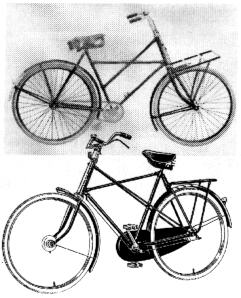 The necessity of this improvement in
comparison with the added cost and weight is debatable, depending on the use of the
bicycle. Anyway, the improved torsional stiffness of a cross frame is striking. Regular
ladies' frames tend to 'sag', making a cross frame design an option worth thinking about.
A regular diamond-frame is strong enough for everyday use, but in the case of an accident
it can become obvious what the better triangular design can stand. The necessity of this improvement in
comparison with the added cost and weight is debatable, depending on the use of the
bicycle. Anyway, the improved torsional stiffness of a cross frame is striking. Regular
ladies' frames tend to 'sag', making a cross frame design an option worth thinking about.
A regular diamond-frame is strong enough for everyday use, but in the case of an accident
it can become obvious what the better triangular design can stand.

These advantages are of all times and do not explain why the
popularity of this type of bicycle has changed so much. Obviously, it has been a matter of
fashion. Cross frames stand out, and in times that bicycles attract attention, it can be
used to an advantage. Manufacturers want to offer more than their competitors, and the
consumer likes to have a special bicycle. After a couple of years, different ways are
found to impress ones neighbour. All this taken into consideration and looking at the
history of the cross frames as outlined above, things can become more clear.
On the next page, different types of
cross frames are shown, along with the applicable brands and years. The focus lies on
designs (also) made by Dutch brands. This overview is certainly not complete.

A special bicycle to be named in this context but skipped in the overview, is the
Dursley-Pedersen. It was patented in 1893 and taken into production in 1897. This is
actually a pure cross frame design. Mads Rasmussen from Denmark has set up a comprehensive
homepage about Dursley Pedersen
bikes. |
Translation by Dirk den
Hamer. Thank you, Dirk!
Copyright by Jan
van den Elshout and Herbert Kuner, © 2000 ...
All rights reserved.

Last update: 03/20/2003
|